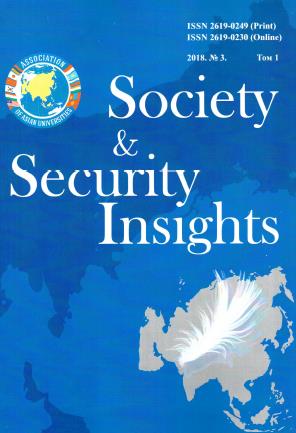MIGRATIONAL ACTIVITY OF RUSSIAN-SPEAKING POPULATION AND FUNCTIONING OF RUSSIAN LANGUAGE IN THE COUNTRIES-MEMBERS OF THE COMMONWEALTH OF INDEPENDENT STATES
Main Article Content
Abstract
The purpose of this article is to analyze migrational activity in the post-Soviet space, changes in ethnic composition in the CIS countries and their role in peculiarities of preservation, functioning and representations about the Russian language, its main characteristics and proficiency among population from CIS countries. Empirical data was collected during the sociological research, fulfilled in 2017 in six countries members of the Commonwealth of Independent States (CIS): Armenia, Belarus, Kazakhstan, Kyrgyzstan, Moldova, Tajikistan, n = 1400. Information-gathering methods included formal interviews in the place of residence of population aged 18 to 75 years. Several indicators were used to achieve the goal: representations about the Russian language; assessment of the role of the Russian language; main characteristics of the Russian language; Russian language proficiency. The article states that in considering principal peculiarities of functioning of Russian in the post-Soviet space demographic indicators such as number of population, number of ethnic groups, proportion of Russian and indigenous population in CIS countries, changes in number of Russians after the dissolution of the USSR, external migration indicators should be taken into account. It was concluded that the Russian language proficiency is important for its preservation and functioning on the territory of CIS countries, the Russian language is well preserved in Belarus, at the middle level in Armenia, Kazakhstan, Kyrgyzstan, Moldova and at the lowest level in Tajikistan. The popularity of Russian in respondents’ evaluations is determined by non-linguistic factors and characteristics and associated with successful foreign policy of Russia and development of economic and trade relations of Russia with other countries. The development of the tourist sector and attractiveness of Russia for immigration are significant catalysts of interest towards the Russian language, influence of targeted programs, aimed at enhancing the positions of the Russian language and popularization of the Russian culture is estimated as less significant. Attractiveness of Russia for immigration, increase of migration streams are important incentives for development and preservation of the Russian language.
Downloads
Metrics
Article Details
Authors retain the copyright of their manuscripts, and all Open Access articles are distributed under the terms of the Creative Commons Attribution License, which permits unrestricted use, distribution, and reproduction in any medium, provided that the original work is properly cited.
References
Русский язык в мире: доклад Министерства иностранных дел Российской Федерации. Москва, 2003. URL: http://www.mid.ru/foreign_policy/humanitarian_cooperation/-/
asset_publisher/bB3NYd16mBFC/content/id/493778 (дата обращения: 03.10.2017).
Животовская И.Г. Международная миграция в условиях современной глобализации: динамика и социально-экономические последствия. В кн.: Глобализация как фактор социальных перемен в современном мире. Москва: ИНИОН, 2012. С. 128–180.
Итоги переписей населения в странах Содружества независимых государств (раунда-2002): Статистический сборник. Москва, 2006.
Максимова С.Г., Авдеева Г.С., Максимов М.Б. Миграционные процессы и социально-экономическая безопасность приграничных регионов России. Вестник Алтайского государственного аграрного университета, 2013, No 11 (109), 123–127.
Рязанцев С.В., Гребенюк А.А. «Наши» за границей. Русские, россияне, русскоговорящие, соотечественники: расселение, интеграция и возвратная миграция в Россию. — М.: ИСПИ РАН, 2014. — 238 с.
De Haas H., The migration and development pendulum: a critical view on research and policy. International Migration, 2012, 50 (3), 8–25.
FAO. Addressing the root causes of migration and harnessing its potential for development 2016. Rome: Food and Agriculture Organization, 2016.
Kobzar S., Hellgren T., Hoorens S., Khodyakov D., Yaqub O. Evolving Patterns and Impacts of Migration. Global Societal Trends to 2030. Thematic Report No 4, 2015.
Maximova S.G., Noyanzina O.Y., Omelchenko D.A., Avdeeva G.C., Maximov M.B. Methodology of diagnostics of interethnic relations and ethnosocial processes. International Journal of Environmental and Science Education, 2016, 11(11), 4885–4893.
Migration as a Development Challenge: Analysis of Root Causes and Policy Implications. UNESCO, 2017.
UNICEF. Migration and Youth: Challenges and Opportunities. Edited by J. Cortina, P. Taran & A. Raphael on behalf of the Global Migration Group. 2014.

